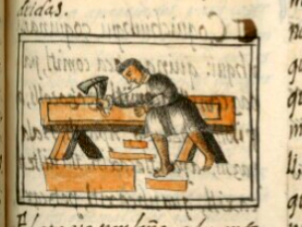cuauhnanamaca (FCbk10f59r)
This iconographic example, featuring the verb “to sell wood” (cuauhnanamaca), is included in this digital collection for the purpose of making comparisons with related hieroglyphs. The term selected for this example comes from the text near the image in the Digital Florentine Codex. There is no gloss, per se. This example shows a fully clothed man in a ¾ view, facing left. His clothing is shaded, giving it a three-dimensionality, a European artistic tradition. A small speech scroll emitting from his mouth suggests some degree of status for having a voice. Being fully dressed in a European style also supports this. The wood seller holds an axe in his right hand. Next to him is a work table, and on the ground near his feet are four planks of varying sizes that he has made and is likely selling, according to the Nahuatl text. The reduplication in the verb (-nana-) does not seem necessary, but perhaps the intention is to convey a quantity of wood, and the visuals offer several pieces of varying size. The verb nanamaca, to sell water, does not seem relevant here.
Stephanie Wood
Wooden beams and planks appear across this digital collection with frequency. Note how the houses (calli) typically have a beam-framed entrance. The grain storage containers (cuezcomatl) sometimes sat on wooden beams on rocks, to keep the grain off the ground. Perhaps these were wooden platforms (tlapechtli). Drums, carrying frames, ladders, fishing nets, axe handles, flagpoles, weapons, yokes for enslaved people, digging sticks, spindles, skull racks, and so much more. See some examples of planks below. It is not unusual for them to have a hole in one end and be dragged along the ground with a rope.
Stephanie Wood
Quauhnanamaca
cuauhnanamaca
Stephanie Wood
1577
Jeff Haskett-Wood
vendedor, tabla, tablas, tablón, tablones, carpintero, carpinteros, hacha, hachas
cuauhnanamaca, to sell wood, https://nahuatl.wired-humanities.org/content/cuauhnanamaca
cuauhnamacac, wood seller, https://nahuatl.wired-humanities.org/content/cuauhnamacac
cuahui(tl), tree or wood, https://nahuatl.wired-humanities.org/content/cuahuitl-1
-namacaqui (pl. -namacaque), a suffix referring to an occupation, often a merchant selling something; in the Florentine Codex, often written in the singular as -namacac, https://nahuatl.wired-humanities.org/content/namacaqui
namaca, to sell, https://nahuatl.wired-humanities.org/content/namaca
nanamaca, to sell water, https://nahuatl.wired-humanities.org/content/nanamaca
vender madera
Stephanie Wood
Available at Digital Florentine Codex/Códice Florentino Digital, edited by Kim N. Richter and Alicia Maria Houtrouw, "Book 10: The People", fol. 59r, Getty Research Institute, 2023. https://florentinecodex.getty.edu/en/book/10/folio/59r/images/0 Accessed 10 September 2025.
Images of the digitized Florentine Codex are made available under the following Creative Commons license: CC BY-NC-ND (Attribution-NonCommercial-NoDerivs 4.0 International). For print-publication quality photos, please contact the Biblioteca Medicea Laurenziana ([email protected]). The Library of Congress has also published this manuscript, using the images of the World Digital Library copy. “The Library of Congress is unaware of any copyright or other restrictions in the World Digital Library Collection. Absent any such restrictions, these materials are free to use and reuse.”




